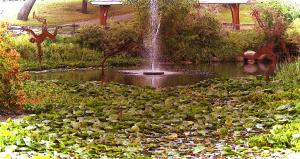| Commentary and Philosophy Poetry posted November 17, 2013 | Chapters: |
...94 95 -96- 97... 
|
      |
A Pantoum Sonnet
A chapter in the book Commentary and Philosophy
Their Spirits Dance
by Treischel

Their Spirits Dance (A Pantoum Sonnet) Their spirits dance on water's waves, Delighting in refreshing spray, As droplets pelt these prancing braves, On sacred pond bronzed warriors play. Delighting in refreshing spray, They flop atop the lily pads. On sacred pond bronzed warriors play, These ghosts of long past native lads. They flop atop the lily pads, Reminders of what once had been. These ghosts of long past native lads, Someday their hopes may rise again. As droplets pelt these prancing braves, Their spirits dance on water's waves. |
 Recognized |
This fountain pond is in a park in Downtown Bemidji, Minnesota. Not sure what the city fathers had in mind when they had this commissioned, but it spoke to me of spirits of Native Americans who once called this spot home. Possibly a sacred pool along the shores of Lake Bemidji, close to the headwaters of the Mississippi. Bemidji is the first lake formed by the Mississippi as it heads south from Itaska. Relations between the early settlers and the Indian population were friendly. Prior to the 1880's a band of about fifty Leech Lake Indians (a branch of the Ojibwa) lived along the south shore of a lake with their elder, Shaynowishkung. They called that lake Bemidjigumaug, meaning 'river or route flowing crosswise' because the current of the Mississippi flows crosswise across the lake. Shaynowishkung's daughter, Bahgahmaushequay, married Merian Carson, thereby cementing the relationship between the original inhabitants and the white newcomers. The white pioneers, honored Shaynowishkung for his staunch friendship. Although he was not a tribal chief, Shaynowishkung was respectfully called 'Chief Bemidji' by those he provided food and shelter for while they were building their homestead cabins. Eventually, all their lands were overtaken by the settlers and the Indians were removed to reservations at Red Lake and Leach Lake. This park spoke to me as an echo of those gracious Indians who ended up being betrayed.
This poem is a Pantoum Sonnet. Once again I was introduced to this form by Gungalo in her poem, Tomorrow's Dawn.
A Pantoum Sonnet combines the characteristics of the two formats. A Pantoum is a repeating poem whose second and fourth lines become the first and third lines of the next stanza. The Sonnet is a 14 line poem with 12 lines of abab rhyming and two closing rhymed lines. It can be formed in the contemporary manner of three Quatrains with closing couplet, of the traditional way of 14 lines together (as done here). In either case, the rhyme scheme for this Pantoum Sonnet is:
A1/B1/A2/B2/ B1/C1/B2/C2/ C1/D1/C2/D2/ A2/A1
Gungalo chose to use the traditional iambic pentameter for her tempo. I chose the less conventional, but equally acceptable, iambic tetrameter for mine.
This photograph was taken by the author himself.
Pays
one point
and 2 member cents. This poem is a Pantoum Sonnet. Once again I was introduced to this form by Gungalo in her poem, Tomorrow's Dawn.
A Pantoum Sonnet combines the characteristics of the two formats. A Pantoum is a repeating poem whose second and fourth lines become the first and third lines of the next stanza. The Sonnet is a 14 line poem with 12 lines of abab rhyming and two closing rhymed lines. It can be formed in the contemporary manner of three Quatrains with closing couplet, of the traditional way of 14 lines together (as done here). In either case, the rhyme scheme for this Pantoum Sonnet is:
A1/B1/A2/B2/ B1/C1/B2/C2/ C1/D1/C2/D2/ A2/A1
Gungalo chose to use the traditional iambic pentameter for her tempo. I chose the less conventional, but equally acceptable, iambic tetrameter for mine.
This photograph was taken by the author himself.

You need to login or register to write reviews. It's quick! We only ask four questions to new members.
© Copyright 2024. Treischel All rights reserved.
Treischel has granted FanStory.com, its affiliates and its syndicates non-exclusive rights to display this work.

